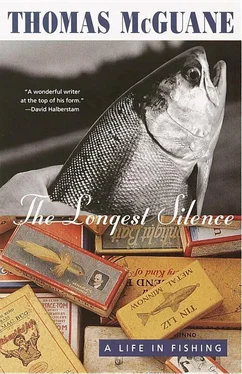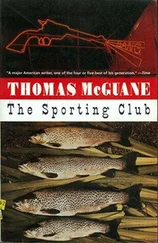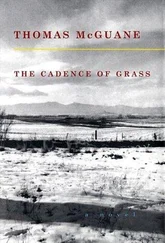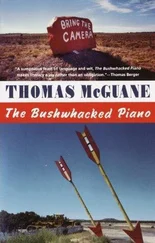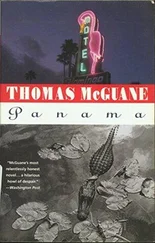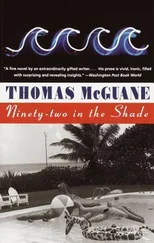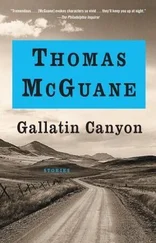I run it up to 4500 rpm. The bow lifts, then the stern comes up under the power and kicks the bow down. I slack off to 3600 and we bank and turn through the markers. Key West drops quickly behind and finally clusters at the end of our long arrow of wake. There is a sense of liberation as we run, civilization melting away while another country — mangrove keys, shallows, and open seas — forms around us.
When you pass them, the mangroves empty themselves of cormorants; the birds drop down slapping the water with their wing tips, then shudder as though it had been a close call. The backcountry is full of pelicans, frigate birds, ospreys, bitterns, egrets, and herons, not to speak of that mass of small shorebirds such as plovers, avocets, turnstones, surfbirds, and phalaropes or a number of glamorous “occasionals,” as the bird books call them: ibises, eagles, and the utterly incredible roseate spoonbills, the color of a Miami streetwalker’s lipstick, that wheel out behind a sandy little key.
We stake the skiff in a small basin near the Northwest Channel. The shrimpers are coming in sporadically from the Gulf of Mexico, trawling booms swaying and diesel engines sounding like farm tractors at this range. We are watching for tarpon moving in the big channel to graze off or shortcut toward the smaller channels shoreward of us. We are staked — that is, tied to the push pole, which is shoved into the bottom along a sandbank that separates the channel from the basin, knowing it will deflect tarpon up into shallow water, where it is hoped they will be moved to take the fly.
We are using the big rod. It carries a No. 12 saltwater taper line and is a very effective rod for fighting a fish, if not exactly a wand to handle. It is powerful, with a second grip just short of the stripping guide. We have rigged a grizzly-and-orange fly on a 3/0 hook, using an 80 pound shock tippet. Ten inches above that, the 12 pound starts and it is this breaking strength that brackets what pressure the angler can put on the fish.
We take turns with the rod, watching for incoming fish that can appear and blow by too quickly if one’s alertness flags. Very early on, some tarpon roll in the big channel. They are clearly travelers, though, and will keep right on going — to Mexico, for all we know.
After a bit, a good-size shark glides under the boat. Touched with the rod tip, he moves off in a surge. A little later a hawksbill turtle peers up at us from green water, then, frightened, races off at a speed one doesn’t associate with turtles; his front flippers are a blur of effort, while the back ones cross and trail.
Guy stands up on one bait well and looks intently through the binoculars. “The damned guide boat,” he reports, “is sitting on our next stop.” Sure enough, the skiff is at Mule Key, exactly the place where we would be getting the phase of tide we wanted in another half-hour. “And you know what else?” The answer was posed in the tone of his question.
“Yes,” I said ruefully, “he’s fighting a fish.”
We start looking at our watches. We’re not getting any shots on this spot, have been cut off on the next, and when the men in the guide boat are done with their present fish, they very well might make a move to our next stop. Guy looks through the glasses.
“What’s he doing?”
“He broke the fish off,” Guy said. “There are two of them. They’re sitting in the boat to rerig.”
“I feel sort of frustrated here,” I said.
“I do, too.”
“If we don’t crank up — I know this is irrational — if we don’t crank up I’m afraid we’re going to be following him all day long.”
“Let’s slip the stake,” said Guy, “and blow all the way to Big Mullet before he gets his nose out of that tackle box.”
I slip the pole out of the bottom, coil the line on the bow, put the pole on its chocks and secure it with the shock cord, then start the engine. I idle into Northwest Channel, then run it up to 5400 rpm, all the way to the stop, so that we are truly flying, running through the banks with a mean tide chop beating our back teeth loose.
We get two-thirds of the way across Northwest Channel and the rival guide sees the push pole on our gunwale and realizes what is happening to him. He quick-hands the rod he’s rigging to his companion and starts the engine. Our problem is to hit the run-through channel in the Mule Key bank directly on the nose or else we’ll be sawed off by our opponent.
The guide boat wheels around and things are still at the educated-guess stage. From here the bank looks solid and we appear to be heading on a collision course: running aground. Now the other boat is flying full tilt as well, on an interception course. It is sufficiently neck and neck that we’ll have to find another place to fish if I’m forced to shut down the engine on the shallow bank and feel my way along for a place to sneak through.
But then a piece of the bank seems to peel away before our eyes and suddenly we spot a solid green creek running through the hard stuff. We cross the bank at 5000 rpm and shut off. In our new silence we hear the drone of the guide boat taper to an idle a short distance behind us.
“You look back,” says Guy with a smile. We are both of us pretending to survey the basin as though we hardly knew another boat was anywhere in the country. I turn around and see the two men hunched in the idling boat, staring at us without love.
Alas, it is a far cry from the genial gatherings of anglers on the Test or the Itchen. When flats fishermen run into each other on the water, smiles and jolly waves notwithstanding, it is more like war. When information is asked for, a bum steer quite naturally springs to the lips. I rather suspect, though, that the true scoop on the Test and the Itchen would indicate that those anglers, tweeds and all, have the needle into each other as thoroughly as we do.
Soon the guide boat is running again, the big engine offering what we interpret as a mild trumpet of resignation. While we fully expect to see them at another stop, at the moment, we have the place to ourselves. Meanwhile, it is as quiet as can be, the water lapping gently on the sides of the skiff and pearly summer clouds resting along the horizon.
We tilt the engine and Guy begins to pole. He was a collegiate rower and poles better than I do, with a steady, persistent beat that is perfect for surveying an area when you are not absolutely sure of finding fish. Immediately we begin seeing life; clusters of spotted eagle rays bustle around like nuns, barracudas appear near the boat without ever having been seen in the act of swimming over, small sharks come, stingrays and houndfish. But not, for the moment, any tarpon. We’re not talking very much. I feel the successive pushes of the pole and hear its steady rise and fall in the water. Occasionally we glide to a stop and I hear Guy lighting a cigarette behind me, and in a moment the boat surges forward again. The bottom is dark with turtlegrass and we look hard to penetrate its surface. At the same time we try to survey a wide range for rollers and watch the surface for the faint wakes that look like a thumbnail pulled gently along under a sheet of silk. What you see more than anything is movement; the laid-up or sleeping fish are the toughest to spot.
There is a little breeze now and a few horsetail clouds high in the sky, brilliantly white and lacquered. A radiant drop curtain of fuchsia light stands on edge from the Gulf Stream south of us. East across the channels Key West can still be seen, like a white folding ruler, in sections on the blue expanse.
Guy says “tarpon” so quietly that I wonder if he means tarpon in general, but with a certain dread I realize he has spotted fish and a moment later I see a large single swimming with easy sweeps, quite black and bulky looking, moving on a course we will easily intercept. This means it will be entirely up to me. I’m trailing enough line for my false cast and have already begun that rather tense process of trying to figure our range as it is modified by the progress of the skiff in one direction and that of the tarpon in another. That the fish itself looks about as manageable as a Cape buffalo is little help in the finer calculations of the mind. I know from experience that this peaceful meandering fish can offer a scarifying performance, calling into question (if usually theoretically) whether or not the angler is actually safe.
Читать дальше
